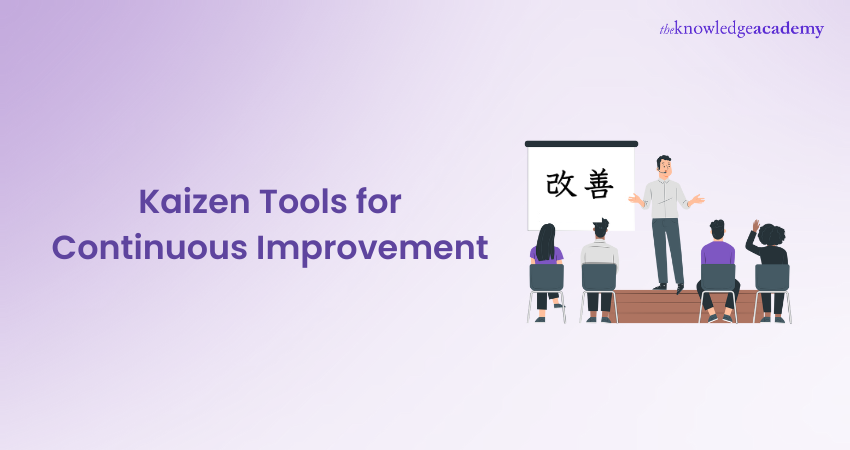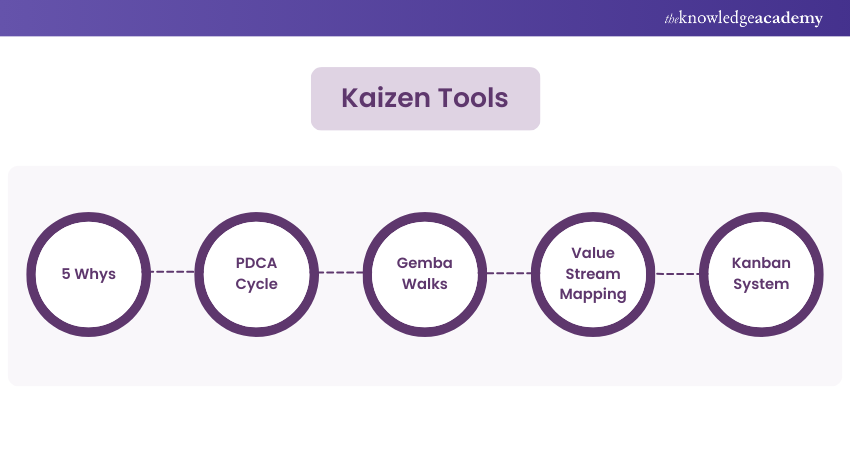We may not have the course you’re looking for. If you enquire or give us a call on + 1-866 272 8822 and speak to our training experts, we may still be able to help with your training requirements.
We ensure quality, budget-alignment, and timely delivery by our expert instructors.

Kaizen, the philosophy of continuous improvement, offers a wide array of tools and templates known as Kaizen Tools. These tools are designed to aid organisations in identifying inefficiencies, analysing processes, and implementing effective changes.
In this blog, we will delve into the world of Kaizen Tools, exploring their applications and benefits. By understanding how to utilise these tools, organisations can enhance their problem-solving capabilities. Explore a range of Kaizen Tools designed to streamline processes, boost productivity, and foster a culture of continuous improvement.
Table of Contents
1) What is Kaizen?
2) What are Kaizen Tools?
3) Importance of Kaizen Tools
4) Kaizen Tools success factors
5) Conclusion
What is Kaizen?
Kaizen, originating from Japan, embodies the concept of "continuous improvement."This philosophy advocates relentless and consistent enhancement across all facets of life. Kaizen is a robust methodology in business to identify and eradicate inefficiencies and waste, ultimately boosting efficiency and quality.
At the core of the Kaizen method lies the fundamental belief that every individual, regardless of their role or position, can contribute to enhancing a process. Even minor suggestions or improvements are valued and can lead to substantial advancements. This inclusive approach has proven remarkably successful, finding applications in various industries, from manufacturing, where it initially emerged, to the intricate world of healthcare.
In essence, Kaizen encapsulates a mindset that fosters ongoing growth and refinement, recognising that pursuing perfection is an endless journey and that even incremental progress is a significant achievement.
What are Kaizen Tools?
Kaizen Tools refers to a collection of methodologies (Kaizen 5s), techniques, and frameworks that support the implementation of Kaizen, the philosophy of continuous improvement. These tools provide structured approaches to problem-solving, process analysis, and improvement initiatives within an organisation. They help identify inefficiencies, eliminate waste, and drive positive change. Examples of Kaizen Tools include the 5 Whys technique, the PDCA Cycle, Gemba walks, Value stream mapping, and the Kanban system.

Each of the Kaizen Tools serves a specific purpose and offers a systematic approach to enhance operational effectiveness and foster a culture of continuous improvement. By leveraging these tools effectively, organisations can optimise their processes, engage employees, and achieve sustainable improvements in performance and productivity. Given below is a comprehensive list of Kaizen Tools:
Bring efficiency to your organisation with Kaizen Training!
5 Whys
The 5 Whys in Root Cause Analysis technique is one of the popular Kaizen Tools used to delve deep into the root cause of a problem. By repeatedly asking "why" five times, you can uncover underlying issues and identify the true cause. This helps in addressing the root cause rather than just treating the symptoms, enabling sustainable improvements.
Try our Certified Kaizen Foundation & Practitioner Course today to reach unseen efficiency!
PDCA Cycle
The Plan-Do-Check-Act (PDCA) Cycle, also known as the Deming Cycle, is one of the essential Kaizen Tools that follows a systematic problem-solving approach. It involves planning, executing, checking the results, and making necessary adjustments. The PDCA Cycle plays a crucial role in Kaizen Events, promoting iterative improvement and continuous learning, enabling organizations to refine their processes and achieve incremental enhancements over time.
Gemba walks
One of the popular Kaizen Tools which involve going to the actual workplace to observe and understand the current state of operations is Gemba walks. This hands-on approach allows leaders and managers to gain firsthand knowledge about the work environment, identify inefficiencies, and engage with employees to gather insights and suggestions for improvement. Gemba walks facilitate a deeper understanding of processes and encourage employee involvement in driving changes.
Discover the potential of continuous improvement with Certified Kaizen Foundation Course!
Value stream mapping
Value stream mapping is one of the visual Kaizen Tools that provides a holistic view of the entire process flow, from start to finish. It helps identify waste, bottlenecks, and areas for improvement within the value stream. By analysing each step and the associated time and resources, organisations can streamline processes, eliminate non-value-added activities, and enhance overall efficiency.
Kanban system
The Kanban system is one of the visual method-based Kaizen Tools for managing workflow and inventory levels. It uses cards or boards to represent tasks or items, visually indicating the progress and status of each. By limiting work in progress, organisations can avoid overburdening resources and improve overall flow and productivity. The Kanban system promotes a balanced workflow, facilitates prioritisation, and enables teams to focus on completing tasks efficiently.
Try our Certified Kaizen Foundation & Practitioner Course today to reach unseen efficiency!
Importance of Kaizen Tools
The essence of Kaizen, centered on continual improvement, assures the adoption of superior and more efficient methods for task execution. Beyond enhancing processes, Kaizen fosters a culture of effective communication that transcends boundaries between work areas, shifts, and organisational hierarchies.
To harness the full potential of Kaizen Tools , their application should be in lockstep with the company's overarching goals and objectives. This alignment ensures that the Kaizen Tools employed are not just tools for the sake of change but serve as strategic assets aimed at advancing the company's mission.
By harmonising Kaizen Tools with organisational objectives, companies can guarantee that their endeavors are not just incremental adjustments but are genuinely propelling the company towards its intended destination. This synergy between Kaizen principles and organisational goals forms a powerful synergy, reinforcing the commitment to perpetual improvement while staying firmly on the path to long-term success.
Discover the potential of continuous improvement with Certified Kaizen Foundation Course!
Kaizen Tools success factors
Continuous improvement, embodied by the Kaizen philosophy, is a journey with no endpoint, making it a fundamental, long-term commitment for businesses. To thrive on this path, companies must cultivate the right mindset and foster a culture that wholeheartedly embraces Kaizen principles. Furthermore, having the appropriate tools and techniques is indispensable for identifying and eliminating waste, driving efficiency and quality enhancements.
Here are three pivotal factors for the successful implementation of Kaizen:
a) Cultivating a Kaizen culture: Building a workplace culture that champions continuous improvement is essential. This entails encouraging all employees to actively participate in suggesting and implementing improvements, regardless of their role. Leaders must lead by example, demonstrating their commitment to Kaizen principles.
b) Investing in training and education: Equipping your workforce with the knowledge and skills required for Kaizen is paramount. Training programs emphasising problem-solving, data analysis, and collaboration empower employees to contribute meaningfully to the improvement process.
c) Regular assessment and feedback: Implementing Kaizen requires ongoing assessment of processes and outcomes. Regularly gather data, analyse results, and provide constructive feedback to identify areas for further improvement. This iterative approach ensures that Kaizen remains a dynamic force within the organisation.
Embrace the Kaizen methodology for continuous improvement. Discover how incremental changes drive lasting success and innovation!
Conclusion
Incorporating the right Kaizen tools and templates can significantly enhance an organisation's continuous improvement journey. From the 5 Whys and PDCA cycle to Gemba walks, value stream mapping, and the Kanban system, these tools empower organisations to identify issues, streamline processes, engage employees, and drive sustainable improvements. Leveraging these tools effectively allows organisations to embrace Kaizen principles and achieve long-term success in their pursuit of continuous improvement.
Unleash the potential for continuous improvement with Certified Kaizen Practitioner Course!
Frequently Asked Questions
What are the 5S tools of Kaizen?

The 5S tools of Kaizen are a set of fundamental principles and practices aimed at optimising workplace organisation and efficiency. Each "S" represents a key element:
a) Sort: The first step involves eliminating unnecessary items from the workspace, ensuring that only essential tools and materials are present.
b) Set in order: This step focuses on arranging and organising the remaining items logically and efficiently, enhancing accessibility and reducing wasted time searching for things.
c) Shine: Maintaining cleanliness and tidiness is crucial. Regular cleaning and maintenance activities ensure a safe and productive work environment.
d) Standardise: Establishing clear, standardised procedures and visual controls helps maintain the gains achieved through the first three S's.
e) Sustain: The final step involves fostering a culture of continuous improvement by encouraging employees to sustain the 5S practices over time, ensuring lasting benefits in terms of efficiency and quality.
What are the 5 elements of Kaizen?

Kaizen, a Japanese term for "continuous improvement," comprises five key elements:
a) Teamwork and involvement: Kaizen encourages collective problem-solving and active participation of all employees. Teamwork is vital to harnessing diverse perspectives and ideas for improvement.
b) Personal discipline: Kaizen emphasizes self-discipline in adhering to processes and standards. It requires individuals to take ownership of their roles and responsibilities.
c) Improved morale: Kaizen fosters higher morale and job satisfaction by involving employees in decision-making and recognizing their contributions.
d) Quality circles: Small groups, known as quality circles, collaborate to identify issues and propose solutions, promoting ownership and empowerment.
e) Suggestions for improvement: Kaizen thrives on continuous feedback and suggestions for improvement, creating a culture where even minor enhancements are valued and implemented.
What are the Kaizen problem solving tools?

Kaizen problem-solving tools are essential instruments for continuous improvement efforts. These tools facilitate the identification and resolution of issues within processes. Some prominent Kaizen problem-solving tools include the PDCA (Plan-Do-Check-Act) Cycle, 5 Whys technique, Fishbone diagram (Ishikawa diagram), Gemba walks, Pareto analysis, and Value stream mapping .
The PDCA cycle guides a structured problem-solving process, while the 5 Whys delves deep into root cause analysis. Fishbone diagrams visualise causes and effects, Gemba walks promote on-site problem discovery, Pareto analysis prioritises issues, and Value Stream Mapping optimises workflows. These tools empower organisations to address challenges systematically and drive continuous improvement.
What are the other resources and offers provided by The Knowledge Academy?

The Knowledge Academy takes global learning to new heights, offering over 3,000 online courses across 490+ locations in 190+ countries. This expansive reach ensures accessibility and convenience for learners worldwide.
Alongside our diverse Online Course Catalogue, encompassing 19 major categories, we go the extra mile by providing a plethora of free educational Online Resources like News updates, Blogs, videos, webinars, and interview questions. Tailoring learning experiences further, professionals can maximise value with customisable Course Bundles of TKA.
Upcoming Business Improvement Resources Batches & Dates
Date
 Certified Kaizen Foundation & Practitioner
Certified Kaizen Foundation & Practitioner
Thu 15th May 2025
Thu 17th Jul 2025
Thu 18th Sep 2025
Thu 13th Nov 2025






 Top Rated Course
Top Rated Course



 If you wish to make any changes to your course, please
If you wish to make any changes to your course, please


